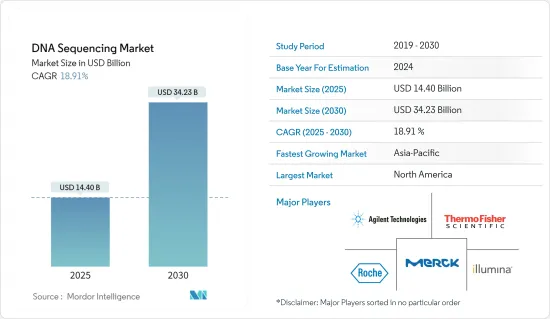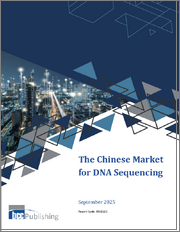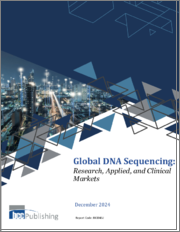
|
시장보고서
상품코드
1687904
DNA 시퀀싱 : 시장 점유율 분석, 산업 동향, 통계, 성장 예측(2025-2030년)DNA Sequencing - Market Share Analysis, Industry Trends & Statistics, Growth Forecasts (2025 - 2030) |
||||||
DNA 시퀀싱 시장 규모는 2025년에 144억 달러, 2030년에는 342억 3,000만 달러에 달할 것으로 예측되고 있습니다. 예측 기간(2025-2030년)의 CAGR은 18.91%를 나타낼 전망입니다.

COVID-19 팬데믹은 COVID-19 감염의 치료제 및 진단제 개발에 있어서 DNA 시퀀싱 기술 수요를 증가시켜 조사 대상 시장에 긍정적인 영향을 미쳤습니다. 예를 들어, 2021년 11월, 인도의 과학 기술 담당 국무부 장관은 생명공학부(DBT)가 COVID-19에 대한 1,000,000개의 유전체 및 DNA 시퀀싱을 완료하고, 57,000개의 샘플을 가진 5개의 COVID-19 바이오리포지토리가 연구 개발 및 제품 개발을 위해 생물자원은 학계와 산업계의 연구 개발 및 제품 개발을 위해 제공되었다고 발표했습니다.
시장 성장을 가속하는 특정 요인으로는 DNA 시퀀싱 기술의 진보, 임상 진단 및 신약에 대한 응용 증가, R&D 투자 증가 등이 있습니다. DNA 시퀀싱은 진단, 맞춤형 의료, 바이오 마커, 법의학, 생식 의료 및 기타 분야에 적용됩니다. DNA 시퀀싱 기술은 암 진단 및 치료법의 임상 연구 개발에 큰 가능성을 가지고 있습니다. 최근, 차세대 시퀀싱(NGS) 기술은 1회의 검사로 다수의 유전자에 걸친 임상적으로 대처 가능한 유전자 변이를 탁월한 속도로 동정하고, 그 특징을 밝히는 하이 스루풋하고 저렴한 접근법으로서의 능력을 실증하고 있습니다. 2022년 6월 Journal of Pure and Applied Microbiology 잡지에 게재된 연구 논문에 따르면, DNA 시퀀싱법은 임상 진단 실험실이나 연구 실험실에서 채용되어 고품질의 결과를 내기 위해 시대와 함께 진화해 왔습니다. 치료 및 진단을 위한 새로운 표적의 확인을 돕고 환자 관리의 시야를 넓히고 있습니다. 그러므로, 임상 진단 및 창약에서 DNA 시퀀싱의 응용 증가는 예측 기간 동안 시장 성장을 가속할 것으로 예상됩니다.
1970년대의 2D 시퀀싱에서 DNA 시퀀싱으로, 시퀀싱의 기술 진보는 긴 길을 걸어왔습니다. 최근, Illumina/Solexa, ABI/SOLiD, 454/Roche, Helicos 등의 플랫폼이 고처리량 기능적 유전체 연구에 독자적인 전망을 제공합니다. 또한 기술적으로 첨단 DNA 시퀀싱 플랫폼 출시가 증가하고 있으며 시장 성장을 가속할 것으로 기대되고 있습니다. 예를 들어, 2021년 12월, Singular Genomics Systems, Inc.는 벤치탑 시퀀서 G4의 상업 출시를 발표했습니다. 이 NGS 플랫폼은 혁신적인 고성능 화학 및 고급 엔지니어링을 사용하여 종양학 및 면역학 연구를 포함한 다양한 용도에 정확성, 유연성, 속도 및 전력을 제공합니다.
또한, 연구개발 활동 증가는 창약 및 개발에 있어서 DNA 시퀀서의 역할에 의해 수요를 높일 것으로 예상됩니다. 예를 들어, 2022년 7월, 캘리포니아의 유전체학 신흥 기업은 새로운 고처리량 저비용 시퀀싱 플랫폼을 사용하여 100달러의 인간 전체 유전체을 제공하기 위해 6억 달러의 자금을 조달했습니다.
따라서 위의 모든 요인이 시장 성장을 가속할 것으로 예상됩니다. 그러나 복잡한 데이터 분석과 숙련된 전문가 부족으로 인해 예측 기간 동안 시장 성장이 억제될 수 있습니다.
DNA 시퀀싱 시장 동향
차세대 시퀀싱(NGS) 부문이 큰 시장 점유율을 차지할 것으로 예상되며 예측 기간 동안에도 비슷한 동향을 따릅니다.
NGS 부문은 NGS의 애플리케이션 증가, 속도, 비용, 정확성, 기존 기술의 효율적인 대체, NGS 기술을 필요로하는 신약 응용 등의 요인에 의해 견인됩니다. 이 기술의 장점은 현저하게 저렴하고 신속하며 필요한 DNA 양이 현저히 적기 때문에 전체 부문을 성장시키는 데 도움이 됩니다.
의료 분야에서는 다양한 기술의 진보가 있어 급속한 속도로 성장하고 있으며, 맞춤형 의료의 개발로 이어지고 있습니다. 예를 들어, 2022년 10월 CDC는 미국 미생물학회(ASM)에 NGS 교육을 제공하기 위한 자금을 제공했습니다. ASM은 임상 미생물학의 인력을 NGS 기술에 대해 교육하고, 병원체의 유전체 시퀀싱 능력을 향상시키고, 고급 분자 기술을 사용하여 다음 유행에 대비하기 위해 인지된 훈련을 만들고 제공할 가능성이 높습니다. 또한 ASM의 바이오인포매틱스 파트너를 감염에 대해 교육하여 과학 기술이 공중 보건에 미치는 영향을 더 잘 이해할 수 있도록 할 수 있습니다. 이러한 사례는 NGS에 대한 인지도를 높여 조사 대상 부문에 대한 수요를 높일 것으로 기대됩니다.
게다가 시장 선수의 제품 출시는 예측 기간 동안 시장 성장을 밀어올릴 것으로 예상됩니다. 예를 들어, 2022년 9월 Illumina Inc.(ILMN.O)는 차세대 NovaSeq X 디바이스를 발표했습니다. 이 장치는 연간 20,000개 이상의 총 유전체을 출력할 수 있으며 기존 시퀀서의 2.5배라고 합니다. 게다가 2021년 7월 QIAGEN은 일본의 시스멕스 주식회사와 암 동반진단약의 개발과 상업화를 위한 세계 전략적 제휴를 발표하고, 이 분야에서 QIAGEN의 리더십과 시스멕스의 NGS용 Plasma-Safe-SeqS 기술을 모두 활용하게 됩니다. 따라서 위의 요인으로 인해 이 부문은 예측 기간 동안 성장할 것으로 예상됩니다.
북미가 시장에서 큰 점유율을 차지하고 예측 기간 동안 동일하게 예측
북미는 특히 미국의 정부 및 비정부 기관에 의한 자금 제공 및 지원 활동 증가로 시장을 독점하고 있습니다. 첨단 기술의 채용이 증가하고 정부와 관련 정책의 유리한 지원이 일본에서 DNA 시퀀싱 시장 성장의 주요 촉진요인이 되고 있습니다.
DNA 시퀀싱의 기술적 진보와 제품 출시는 시장 성장을 뒷받침할 것으로 기대됩니다. 예를 들어, 2021년 12월, Roche는 차세대 시퀀서의 샘플 준비를 간소화하고 자동화하고 인적 실수를 줄이고 정밀의료를 전진시키는 AVENIO Edge System을 출시했습니다.
제품 발표, M&A, 제휴 등 시장 기업의 전략적 활동은 DNA 시퀀싱 시장 수요를 끌어올릴 것으로 예상됩니다. 예를 들어, 2022년 9월, Genome Prairie는 PRIESCAN(이전 Western Economic Diversification Canada)과 공동으로 서스커툰 캠퍼스에 있는 Saskatchewan Polytechnic의 BioScience Applied Research Centre(BARC)에 차세대 유전체 시퀀싱 기술을 공식적으로 납품했다고 발표했습니다. 두 개의 유전체 DNA 시퀀싱 장치로 구성된 이 방법을 통해 연구자는 인간의 생물학적 과정을 더 깊이 이해할 수 있습니다.
그러므로 이러한 요인들 덕분에 DNA 시퀀싱 시장은 향후 최대 규모에 이를 것으로 예상됩니다.
DNA 시퀀싱 산업 개요
DNA 시퀀싱 시장은 경쟁이 심하고 소수의 대기업으로 구성되어 있습니다. Agilent Technologies Inc., Bio-Rad Laboratories Inc., Danaher Corporation, Eurofins Scientific, F. Hoffmann-La Roche, Illumina Inc., Merck KGaA, Pacific Biosciences of California Inc., PerkinElmer Inc., Thermo Fisher Scientific Inc. 이러한 기업들은 소비자 수요 증가에 대응하기 위해 노력하고 있으며 포트폴리오 확대를 위해 생산, 유통, 종합적인 품질관리에 대규모 투자를 하고 있습니다.
기타 혜택 :
- 엑셀 형식 시장 예측(ME) 시트
- 3개월간의 애널리스트 서포트
목차
제1장 서론
- 조사의 전제조건과 시장 정의
- 조사 범위
제2장 조사 방법
제3장 주요 요약
제4장 시장 역학
- 시장 개요
- 시장 성장 촉진요인
- DNA 시퀀싱에 있어서의 기술 진보의 고조
- 임상 진단 및 신약에 응용 증가
- R&D 투자 증가
- 시장 성장 억제요인
- 복잡한 데이터의 해석과 숙련된 전문가의 부족
- 법적 및 윤리적 문제
- Porter's Five Forces 분석
- 신규 참가업체의 위협
- 구매자, 소비자의 협상력
- 공급기업의 협상력
- 대체품의 위협
- 경쟁 기업간 경쟁 관계의 강도
제5장 시장 세분화
- 제품 유형별
- 기구
- 소모품(키트, 시약)
- 기타 제품 유형
- 시퀀싱 유형별
- Sanger 시퀀싱
- 차세대 시퀀싱
- 기타 시퀀싱 유형
- 용도별
- 진단
- 맞춤형 의료
- 기타 용도
- 최종 사용자별
- 병원 및 의료기관
- 학술기관 및 연구기관
- 제약 및 바이오테크놀러지 기업
- 기타 최종 사용자
- 지역별
- 북미
- 미국
- 캐나다
- 멕시코
- 유럽
- 독일
- 영국
- 프랑스
- 이탈리아
- 스페인
- 기타 유럽
- 아시아태평양
- 중국
- 일본
- 인도
- 호주
- 한국
- 기타 아시아태평양
- 중동 및 아프리카
- GCC
- 남아프리카
- 기타 중동 및 아프리카
- 남미
- 브라질
- 아르헨티나
- 기타 남미
- 북미
제6장 경쟁 구도
- 기업 프로파일
- Agilent Technologies Inc.
- Bio-Rad Laboratories Inc.
- Danaher Corporation(Integrated DNA Technologies Inc.)
- F. Hoffmann-La Roche Ltd
- Illumina Inc.
- Merck KGaA
- PerkinElmer Inc.
- Thermo Fisher Scientific Inc.
- QIAGEN
- Macrogen Inc.
- Myriad Genetics Inc.
- Eurofins Scientific
- Hamilton Thorne Biosciences
- Pacific Biosciences of California Inc.
제7장 시장 기회와 앞으로의 동향
SHW 25.04.07The DNA Sequencing Market size is estimated at USD 14.40 billion in 2025, and is expected to reach USD 34.23 billion by 2030, at a CAGR of 18.91% during the forecast period (2025-2030).

The COVID-19 pandemic had a positive impact on the market studied, as it increased the demand for DNA sequencing technology in the development of therapeutics and diagnostics for COVID-19 infection. For example, in November 2021, the Union Minister of State for Science and Technology India announced that the Department of Biotechnology (DBT) had completed one lakh genome and DNA sequencing for COVID-19 and that five COVID-19 biorepositories with 57,000 samples had been made available to academia and industry for R&D and product development. Hence, owing to the increasing DNA sequencing-based R&D activities in the development of diagnostic tools or effective therapeutics for COVID-19, the market is likely to continue its significant growth during the forecast period.
Certain factors driving market growth include advances in DNA sequencing technology, increased applications in clinical diagnosis and drug discovery, and increased R&D investments. DNA sequencing has applications in diagnostics, personalized medicine, biomarkers, forensics, reproductive health, and other areas. DNA sequencing technology holds great potential in clinical R&D of cancer diagnostics and therapeutics. Recently, next-generation sequencing (NGS) technology has demonstrated its capacity as a high-throughput and affordable approach to identify and characterize clinically actionable genetic variants across numerous genes at an exceptional speed in a single test. According to a research article published in the Journal of Pure and Applied Microbiology in June 2022, DNA sequencing methods have evolved throughout time to be employed in clinical diagnostic laboratories and research labs to produce high-quality results. It aids in the identification of new targets for therapy and diagnosis, broadening the horizon for patient care. Therefore, the increasing application of DNA sequencing in clinical diagnosis and drug discovery is expected to drive market growth over the forecast period.
The technological advancements in sequencing, from 2D sequencing in the 1970s to DNA sequencing, have come a long way. In recent years, platforms such as Illumina/Solexa, ABI/SOLiD, 454/Roche, and Helicos have provided unique prospects for high-throughput functional genomic research. Furthermore, the increased launch of technologically advanced DNA sequencing platforms is expected to propel market growth. For instance, in December 2021, Singular Genomics Systems, Inc. announced the commercial release of the G4, the benchtop sequencer. The NGS platform uses revolutionary high-performance chemistry and advanced engineering to provide precision, flexibility, speed, and power for a variety of applications, including oncology and immunology research.
Moreover, growing R&D activities are expected to raise demand for DNA sequencing due to its role in drug discovery and development. For instance, in July 2022, a genomics startup in California raised USD 600 million in funding to deliver a USD 100 whole human genome using its new high-throughput, low-cost sequencing platform.
Thus, all the above-mentioned factors are expected to propel the growth of the market. However, the interpretation of complex data and the lack of skilled professionals may restrain the market growth over the forecast period.
DNA Sequencing Market Trends
The Next-generation Sequencing Segment (NGS) is Expected to Hold Significant Market Share and Expected to Follow the Same Trend Over The Forecast Period
The NGS segment is being driven by factors such as the increasing applications of NGS, speed, cost, accuracy, efficient replacement of traditional technologies, and drug discovery applications demanding NGS technology. The advantage of this technology is that it is significantly cheaper, quicker, and requires significantly less DNA, which helps in the overall growth of the segment.
There are various technological advancements in the field of medicine that are growing at a rapid pace and have led to the development of personalized medicine. For instance, in October 2022, the CDC provided the American Society for Microbiology (ASM) with funds to provide NGS training. ASM is likely to create and deliver recognized training to educate the clinical microbiology workforce on NGS technology, boost pathogen genomic sequencing capacity, and prepare for the next pandemic using advanced molecular techniques. It is also likely to educate ASM's bioinformatics partners on infectious diseases, allowing them to better comprehend science and technology's influence on public health. Such instances are expected to increase awareness about the NGS, thereby boosting demand for the segment studied.
Furthermore, product launches by the market players is expected to boost the market growth over the forecast period. For instance, in September 2022, Illumina Inc. (ILMN.O) introduced its next-generation NovaSeq X devices, which the company claims can output more than 20,000 entire genomes per year, or 2.5 times that of previous sequencers. Additionally, in July 2021, QIAGEN announced a global strategic alliance with Japan's Sysmex Corporation for the development and commercialization of cancer companion diagnostics, which will leverage both QIAGEN's leadership in this field and Sysmex's Plasma-Safe-SeqS technology for NGS. Hence, owing to the above-mentioned factors, the segment is expected to grow during the forecast period.
North America Holds a Significant Share in the Market and Expected to do Same during the Forecast Period
North America dominated the market due to an increase in funding and support activities by the government and non-government entities, especially in the United States. The increasing adoption of advanced technologies and favorable support from the government and related policies are the primary driving factors for the DNA sequencing market growth in the country.
Technological advancement in DNA sequencing and product launches is expected to boost the market growth. For instance, in December 2021, Roche launched the AVENIO Edge System to simplify and automate next-generation sequencing sample preparation, reduce human error and advance precision medicine.
Strategic activities by the market players, such as product launches, mergers and acquisitions, and partnerships, are expected to boost the demand for the DNA sequencing market. For instance, in September 2022, Genome Prairie announced the official delivery of next-generation genome sequencing technology to Saskatchewan Polytechnic's BioScience Applied Research Centre (BARC) at its Saskatoon campus in collaboration with PRIESCAN (formerly Western Economic Diversification Canada). The method, which consists of two genomic DNA sequencing equipment, allows researchers to gain a greater understanding of the human biological processes.
Hence, owing to these factors, the DNA sequencing market is expected to be one of the largest in the future.
DNA Sequencing Industry Overview
The DNA sequencing market is highly competitive and consists of a few major players. Companies like Agilent Technologies Inc., Bio-Rad Laboratories Inc., Danaher Corporation, Eurofins Scientific, F. Hoffmann-La Roche, Illumina Inc., Merck KGaA, Pacific Biosciences of California Inc., PerkinElmer Inc., and Thermo Fisher Scientific Inc., among others, hold substantial shares in the DNA sequencing market. These companies are making efforts to address the rising consumer demand and are significantly investing in production, distribution, and total quality management for the expansion of their portfolios.
Additional Benefits:
- The market estimate (ME) sheet in Excel format
- 3 months of analyst support
TABLE OF CONTENTS
1 INTRODUCTION
- 1.1 Study Assumptions and Market Definition
- 1.2 Scope of the Study
2 RESEARCH METHODOLOGY
3 EXECUTIVE SUMMARY
4 MARKET DYNAMICS
- 4.1 Market Overview
- 4.2 Market Drivers
- 4.2.1 Rise in Technological Advancements in DNA Sequencing
- 4.2.2 Increasing Application in Clinical Diagnosis and Drug Discovery
- 4.2.3 Growing Investments in R&D
- 4.3 Market Restraints
- 4.3.1 Interpretation of Complex Data and Lack of Skilled Professionals
- 4.3.2 Legal and Ethical Issues
- 4.4 Porter's Five Forces Analysis
- 4.4.1 Threat of New Entrants
- 4.4.2 Bargaining Power of Buyers/Consumers
- 4.4.3 Bargaining Power of Suppliers
- 4.4.4 Threat of Substitute Products
- 4.4.5 Intensity of Competitive Rivalry
5 MARKET SEGMENTATION (Market Size by Value - USD million)
- 5.1 By Product Type
- 5.1.1 Instruments
- 5.1.2 Consumables (Kits and Reagents)
- 5.1.3 Other Product Types
- 5.2 By Sequencing Type
- 5.2.1 Sanger Sequencing
- 5.2.2 Next-generation Sequencing
- 5.2.3 Other Sequencing Types
- 5.3 By Application
- 5.3.1 Diagnostics
- 5.3.2 Personalized Medicine
- 5.3.3 Other Applications
- 5.4 By End User
- 5.4.1 Hospitals and Healthcare Organizations
- 5.4.2 Academics and Research Institutions
- 5.4.3 Pharmaceutical and Biotechnology Companies
- 5.4.4 Other End Users
- 5.5 Geography
- 5.5.1 North America
- 5.5.1.1 United States
- 5.5.1.2 Canada
- 5.5.1.3 Mexico
- 5.5.2 Europe
- 5.5.2.1 Germany
- 5.5.2.2 United Kingdom
- 5.5.2.3 France
- 5.5.2.4 Italy
- 5.5.2.5 Spain
- 5.5.2.6 Rest of Europe
- 5.5.3 Asia-Pacific
- 5.5.3.1 China
- 5.5.3.2 Japan
- 5.5.3.3 India
- 5.5.3.4 Australia
- 5.5.3.5 South Korea
- 5.5.3.6 Rest of Asia-Pacific
- 5.5.4 Middle-East and Africa
- 5.5.4.1 GCC
- 5.5.4.2 South Africa
- 5.5.4.3 Rest of Middle-East and Africa
- 5.5.5 South America
- 5.5.5.1 Brazil
- 5.5.5.2 Argentina
- 5.5.5.3 Rest of South America
- 5.5.1 North America
6 COMPETITIVE LANDSCAPE
- 6.1 Company Profiles
- 6.1.1 Agilent Technologies Inc.
- 6.1.2 Bio-Rad Laboratories Inc.
- 6.1.3 Danaher Corporation (Integrated DNA Technologies Inc.)
- 6.1.4 F. Hoffmann-La Roche Ltd
- 6.1.5 Illumina Inc.
- 6.1.6 Merck KGaA
- 6.1.7 PerkinElmer Inc.
- 6.1.8 Thermo Fisher Scientific Inc.
- 6.1.9 QIAGEN
- 6.1.10 Macrogen Inc.
- 6.1.11 Myriad Genetics Inc.
- 6.1.12 Eurofins Scientific
- 6.1.13 Hamilton Thorne Biosciences
- 6.1.14 Pacific Biosciences of California Inc.

















